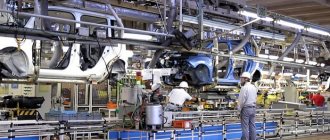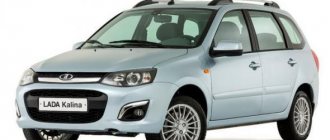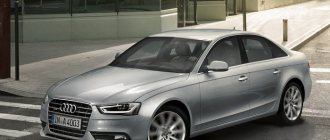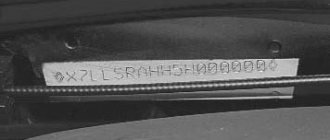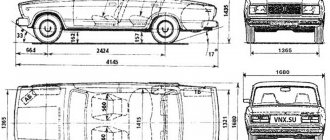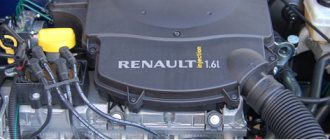The times when a vehicle was considered a luxury, and motorists had only a few domestic cars at their disposal, are a thing of the past.
The modern automobile market offers dozens of different brands, including foreign manufacturers. One of them is Renault.
This brand has earned popularity in the CIS countries due to its reliability, solid appearance and low price.
With the advent of factories in Russia, Renault cars have become even more accessible to domestic car owners.
Where are these cars made? What factories operate in Russia today? How to determine the country of origin by VIN code? These issues require detailed consideration.
General information about RENAULT
is a well-known French corporation that sells its cars in more than 200 countries around the world.
Renault's headquarters are located in the city of Boulogne-Billangcourt, located near Paris.
Renault Group controls several branches at once - Nissan Motors and Renault Samsung Motors, and also owns shares in Dacia (Romania), Volvo, AvtoVAZ and other companies.
In addition to its main line of business, Renault produces engines for various manufacturers, including some Mercedes-Benz models.
In Russia, cars of this brand appeared at the beginning of the 20th century. Thus, in 1916, the activities of Russian Renault JSC were launched, which includes two plants located in Rybinsk and Petrograd.
The main activity was the production of tractors, cars and airplanes.
After the revolution, the work of the factories was stopped due to nationalization, and work resumed only in the 60-70s. It was during that period that an official representative office was opened and many agreements were concluded.
In the early 90s, offices appeared in Moscow, and in July 1998, a strategic agreement to open was drawn up. A year later, the first workshop for assembling Megan models began work, and then Simbol.
Since 2005, a full cycle of car production has been launched, and a year later Renault was recognized as the best-selling car in Russia.
By 2012, Renault's share in the company reached 100%, and in 2014 the name changed - it became Renault Russia CJSC.
Renault hatchbacks have been produced in Russia since 2009 (test assembly), and a full-fledged production started a year later. In 2010, about 160 thousand cars were produced. Another year later, the assembly of Renault Duster was established.
The history of Renault and AvtoVAZ deserves special attention. In 2008, Renault acquired a quarter of all shares of the company, and in 2014 the number of securities in the hands of the French exceeded 50%.
This rapprochement is caused by the desire to revive the domestic auto industry and increase its competitiveness on the domestic and global stage.
Speaking generally about Renault producing countries, we can distinguish several main factories:
- Romania. Cars are produced here mainly for Europe, although some of them also end up in Russia.
- Brazil is one of the largest producing countries for Renault. The only thing is that Brazilian versions of cars do not reach the Russian Federation.
- India. Here production is focused mainly on the domestic market, countries in Africa and Asia.
- Russia. On the territory of the Russian Federation, Renault cars are produced near Moscow and at AvtoVAZ.
Childhood hobby
An inventor, athlete and businessman - this was Louis Renault, the son of ordinary Parisian bourgeois. His father is a successful businessman, and his mother is the daughter of wealthy store owners. From an early age, the boy showed interest in mechanical objects and devices, including motors and electricity.
The Renault family owned a house in Billancourt, near Paris. In the garden of this house there was a barn in which young Louis set up his first workshop. Despite the lack of outstanding academic success, the silent teenager had two extremely important qualities: intuition and hard work.
At the age of 20, Louis began to implement his engineering ideas. The first was a major transformation of the primitive De Dion-Bouton three-wheeler. Louis converted his three-wheeled carriage into a small four-wheeled car, adding his own invention to the design.
This was the world's first gearbox in which torque was transmitted to the rear wheels not by chains, but by a shaft equipped with cardan joints. This final drive design has remained unchanged to this day for rear-wheel drive vehicles. The resulting design turned out to be so successful that it could even be sold, especially since buyers were found quickly.
Literally a year later, in 1989, Louis assembled his first car - a lightweight voiturette (from the French voiturette - cart, cart), which had a power of only 0.75 hp. With. It was this event that marked the beginning of the history of Renault.
The next car is known as the “Model A” with a 1.75 hp De Dion engine. With. on a tubular frame, was the result of the joint work of Louis and his two older brothers and turned out to be very successful. It was with this car that Louis won a bet in 1898 - he drove up the steep Rue Lepic in Montmartre in Paris, which had a slope of 13 degrees, and received the first 12 orders for the production of a car.
Success made it possible to organize (Renault Freres), its full name looked like this: Société Renault Frères in Boulogne-Billancourt, and to equip a small workshop in the outskirts of Paris. In 1899, Louis assembled and sold 15 cars and registered a patent for the gearbox. Soon, all automobile factories of that time began to use Renault's invention.
In which countries and where is Renault Logan assembled? Are there factories in Russia?
The Renault Logan model is a well-known car that has earned popularity due to its affordable price, European appearance and comparative ease of maintenance.
Most of the cars of this brand are produced in Romania at the Dacia plant, which has been owned by Renault since 1999.
On the territory of the Russian Federation, the first generation of the car was produced for ten years, from 2005 to 2015. In 2014, production was launched at AvtoVAZ, where production of the second generation of cars began.
Apart from Russia and Romania, Renault Logan is produced in India, but the cars are almost never exported. This producing country is largely focused on domestic needs.
If we talk about the quality of assembly and compare it at different factories, this question is still open and experts do not have a consensus.
Cars produced near Moscow are often praised, because production there is better organized, and the assembly itself is large-scale.
Ready-made components and panels arrive at the plant, so the workers just have to assemble everything into one mechanism and paint the body.
Despite the difference in production approaches, the problems in both cases are identical - squeaks, uneven gaps, metal susceptibility to corrosion, and others. By the way, the considered shortcomings do not manifest themselves on all Logan cars.
New time and new owner
Country of manufacture of continental tires
In 1945, all factories and the company itself came under nationalization, becoming state property. The name was slightly modified, the brand received the familiar name - Renault, and ceased to exist. Three years after the war, large-scale reconstruction was carried out at the enterprises. Simultaneously with these works, the production of the Juvaquatres car continued.
After modernizing the facilities, the 4CV model was released. Its advantage was hydraulic brakes and shock absorbers. Over the following years, sales of the model amounted to more than 500 thousand cars.
1954 became an anniversary year for the company. Two events were celebrated at once - since nationalization, the millionth car rolled off the assembly line, 2 million were produced in the entire history of the plants. In the Old World, everyone knew whose car was Renault: the country of origin of the car was France. Renault's position in Europe was inviolable, and the concern began to develop the United States market.
Renault Sandero, as well as the Stepway model
The Renault Sandero model belongs to the category of subcompact hatchback, which is based on the Logan chassis.
The main differences from the “predecessor” are a more modern appearance and increased reliability.
The first developments of the model appeared back in 2005, and full production started only towards the end of 2007.
In the same year, Brazil became the first producing country, and a year after that, Argentina.
In Europe, the Dacia Sandero premiered in the spring of 2008 in Geneva. In the same year, mass production was launched in Romania, and a year later - in South Africa.
Since 2009, the car has also appeared in the CIS countries. First in Ukraine, then in Belarus.
The production of cars in the Russian Federation has been established since 2009, at the Renault plant (until 2014 it was called Avtoframos), and the first sales in Russia started only in the spring of 2010.
In 2010, the European market saw the off-road version of Renault Sundero with the “additive” Stepway.
This vehicle has increased ground clearance (19.5 cm without load) and more powerful chassis elements.
In addition, the appearance of the vehicle has also undergone changes - the shape of the bumpers has changed, plastic sills have been installed, powerful wheel arches and roof rails have appeared.
In terms of equipment, the package here is somewhere between Expression and Prestige.
The production of the car in Russia started already in the year of its appearance in Moscow, near Moscow.
What is it for?
Today, automakers have a whole range of measures in their arsenal to ensure the safety of the body panels of their creations from the effects of corrosion, but many people are interested in whether the body is galvanized before purchasing a car, because this is excellent protection for the car.
https://www.youtube.com/watch?v=7fKwKrIKU3k
The first option is to place as many moldings and other protective polymer panels on the body elements as possible. This allows you to secure multiple “problem areas”.
The second method is to use a special coating of the body with certain compounds. Due to this kind of preservation, the metal of the body can “live” for quite a long time.
If the future owner plans to purchase a Renault Logan, then he should not have any concerns about the durability of the bottom. At the factory, this car receives a reliable anti-corrosion coating, which allows it to withstand with enviable dignity the entire galaxy of hardships that plague Russian climatic conditions. The guaranteed period for maintaining protective properties is close to five years. Next, you will need to update the coverage.
We've sorted out the bottom, but what can we tell you about the Renault Logan body panels? The owners have already noticed that during 5-7 years of intensive use, the wings, lower door edges, hood and trunk lid are subject to a fierce attack of the “red disease”.
Currently reading: Replacing the O-ring of the exhaust pipe of Renault Logan 2 - All about cars - New Logan
The zinc protective layer, which most budget employees cannot boast of, requires its application before direct factory painting. This coating can prevent the metal surface from reacting with salt impurities and moisture. Manufacturers of such cars provide guarantees for the safety of the body against through holes for up to 10 years.
Galvanizing technology is very common among European and Japanese manufacturers, among even middle-class cars; no one cares whether the body is galvanized or not, of course, yes. Not only passenger cars, but also commercial trucks are treated with this coating.
Renault Duster
The Renault Duster model is a crossover, distinguished by its compactness and developed at the Renault Technical Center (based in Guiancourt).
The car was first presented at the end of 2009, but under the Dacia brand.
Over time, Renault Dusters of Indian, Brazilian, Colombian and Russian assembly appeared.
In 2014, the millionth car was produced, and one version called Nissan Terrano also appeared.
Erde Tunga worked on the design of the model, and Evgeniy Tkachev was involved in the restyling of 2013. It was he who created the exterior of the new Lada XRAY car.
On the territory of Russia, Duster is assembled in the same place - near Moscow, at the Renault Russia plant.
Each year, more than 150 thousand cars are produced, which fully covers the needs of the domestic market. A certain volume of vehicles is also supplied to neighboring countries.
Let's sum it up
To summarize all of the above, you can be sure that most Renault Logan cars on our roads have a galvanized body with a high degree of corrosion protection. Having such a car, you can be prepared for all the troubles of the Russian climate and operating conditions.
Find out more about the new Logan
- The main reasons why Renault Logan won’t start – Taxi Bolt | New Logan
- Steering column cable 12 12 ST6001551352 Sat. Wholesale and retail.
- Replacing the Renault Logan 1.4 and 1.6 clutch with your own hands: article number and how to adjust
- Silent block beams LOGAN/SANDERO/DASTER 6001549988 2604001 2604001 SASIC. Wholesale and retail.
- Renault Logan knocking in the front suspension on small bumps
- Repair Renault Logan: Bleeding the brake system hydraulic drive
- How to remove the manual transmission handle on a Logan/Sandero/Megan
- ELECTRICAL DIAGRAM RENAULT LOGAN - ELECTRICAL DIAGRAM
Renault Captur
Another model worthy of attention is the Renault Captur, which can be classified as a new product. This is a small crossover based on the 4th generation Renault Clio.
The car was first presented in Geneva in 2013. The start of production in Spain falls on the same year.
In the spring of 2016, a new version of the Renault Captur was presented, featuring higher ground clearance and increased body dimensions. It is based on the well-known Duster.
The car is equipped with two types of engines (1.6 and 2.0 liters), manual transmission, automatic transmission or CVT. Sales of the new model began in the summer of 2016.
Renault Captur is assembled at two factories - Renault and AvtoVAZ (including the new model).
Due to the similarity with Duster cars, there was no need to change the production process.
In 2016, about 15,000 Renault Captur cars were produced at the Renault plant near Moscow, but the existing reserves are enough to increase production to 18-20 thousand cars annually.
Design features
Renault Arcana - where the model is produced, explained that it is based on a modified Global Access platform, which is also a modernization of the same VO from Duster. Even though there are roots, it is hardly appropriate to talk about Arkana as a coupe-shaped Duster. Up to 55% of the chassis elements are new components. The remaining 45% comes from reliable and time-tested design solutions. Regarding many technical nuances, some analogy can be drawn with Kaptur.
The top unit on the model is a turbocharged power unit. What is noteworthy is that its development was carried out by French specialists together with the German Daimler - the concern proposed a design for a head and a block with injection. The French provided the engine base, crankshaft, crankcase, and attachments.
In addition to the completely new turbocharged Renault H5H engine, the buyer will be able to purchase a car with a Renault TCe150 power unit. You can also choose from two types of drives: all-wheel drive, front-wheel drive. For the 1.6 liter engine, the JF015E variator, already known from earlier versions, is installed on the Kaptur. As for the turbo engine, it is equipped with the latest 8th generation JF016E gearbox. It is also installed on the restyled Nissan X-Trail.
Renault Arcana, who assembles and designed the car, publicly assured that the modification with a turbocharged engine has been tested for the possible use of AI-92 gasoline, but for now it is better to use AI-95 gasoline for refueling. The problem here is of a purely documentary nature: the crossover in Russia so far has OTTS exclusively for the use of AI-95 fuel.
Arkana in the history of Russia was the first of all Renault models for which the brand’s new online client platform was designed. The new cross-coupe can be easily assembled using the configurator on the website and prepayment can be made online. Moreover, you can order a test drive via the Internet and have the car delivered to your home. If you have a successful trip and want to buy a car, you can also pay for it in full online. All you have to do is order delivery and wait for the brand new Renault Arkana to arrive from the dealership directly to your doorstep. If you wish, you don’t even have to leave your apartment.
Read further:
Where is Renault Captur assembled?
Renault closes its factories due to coronavirus
Renault cars will be replaced by VAZ engines: how true is this?
Renault Duster 2022: what do you need to know about the updated crossover?
About the fuel consumption of Renault Arcana per 100 km
Renault Megane
Renault Megane cars are considered one of the oldest representatives of the French brand. The car appeared back in 1996 and replaced the rather outdated Renault 19.
Over the 22 years of production, Megane has “survived” three restylings, which almost completely changed its appearance.
Over the years of its existence, the car was produced in the following countries (just a few are given):
- France. The first generation Megane was produced exclusively on the territory of the “native” plant. At the same time, cars for the Russian Federation were assembled in the northern part of France, at the Daewoo plant.
- Spain (Palencia). First and second generation cars were produced here.
- Türkiye. The Oyak-Renault plant produced sedans of the 2nd and 3rd generations.
- Russia. In the Russian Federation, the 3rd generation Renault Megane was produced in 2012-2013, and since 2014, production of a restyled version has been launched near Moscow.
Renault Fluence
Renault Fluence is a compact car, which in 2009 replaced the already outdated Megane.
The platforms of several cars are used here - Nissan S, as well as two Renault models - Scenic and Megan.
Sales of the first cars started in the spring of 2010, first with a 1.6-liter engine, and then with a 2.0-liter engine. Today, a diesel engine has been added to the main range.
The car appeared on the Russian market in 2010. It was then that the production of the vehicle was established in (today Renault-Russia).
Simultaneously with Russian-assembled cars, cars from another manufacturing country, Turkey, appeared on the territory of the Russian Federation, and in 2013, assembly started in South Korea.
Logan domestically assembled
Cars assembled at Russian factories have a stronger body, the assembly of which uses the latest welding technologies. Due to this, they have greater impact resistance and are safer. Robotic technology is used minimally. The emphasis is on hand assembly.
Before releasing a batch of cars onto the market, one car is randomly selected and undergoes a series of tests. Only based on the results of successful tests does the batch reach the market. Thanks to this, you can purchase a quality car at a low price.
How to determine the country of origin by VIN code?
VIN code is a special digital designation, which in some way is a vehicle passport.
Using 17 digits, you can find out the history of the car, determine the date of manufacture, country of origin and other parameters.
The code is based on 17 characters consisting of numbers and Latin letters. “O”, “Q” and “I” do not take part in the code.
It was decided to remove these letters due to the risk of confusion with zero and one.
In addition, a number of other symbols can be made from the letter “I,” which was also one of the reasons for its exclusion.
The structure of the VIN code is divided into three components - WMI, VDS and VIS. From the first part, you can draw a conclusion about the country of origin, in the second - about the characteristics of the vehicle (body type, configuration, model range, etc.), and the third part - about the year of manufacture of the car and serial number.
By the way, the information in part 3 is individual in nature and depends on the car model.
In Renault cars, the VIN code can be found in the following places:
- On the surface of the cylinder block;
- Under the carpet of the front passenger seat;
- Below the arch (near the driver's seat). To see the inscription, you will have to open the doors.
- On the passenger seat pillar (between the hinges).
Now let’s take a closer look at how the VIN code is deciphered for Renault cars.
The first “trinity” of characters shows the country of origin. For example, if the VIN starts with VSY or VS5, the car was made in Spain.
Turkey is designated VF1, and Madagascar is designated GA1.
If the country of origin of Renault is Russia, it also has its own code - X7L.
Other symbols indicate a French assembly, namely VF1 and VF2, MTU, VNE, VF6 and VF8.
Based on the next symbol, you can deduce the body type. Thus, all-wheel drive vehicles are marked with the letter V, rear-wheel drive vehicles with P, and front-wheel drive vehicles with T.
Designations may vary on some machines. For example, if we are talking about a van, the fourth position will have the symbol F. If the vehicle has three doors, the letter G will be written in this place.
If you need to decipher other body types, there are two types of specifications - new and old.
In the first case, station wagons and hatchbacks, distinguished by the presence of three doors, are designated by the letter A and the number 3. If the car has five doors, the designation is different - 5, 6 and the symbol N.
The new type of sedans have the numbers 2 or 4 in the VIN, and the pickup truck is designated by the symbol H.
In older cars the classification is as follows:
- For a hatchback with three doors - C;
- For a three-door station wagon - K;
- For the 5-door station wagon and hatchback - J and B, respectively;
- Minivan - J and so on.
Using the following symbol, you can draw conclusions about the model range. For example, in Renault Megane cars of the 1st and 2nd generation, the symbols A and M are placed in this position, for Clio 2 and Laguna 2 - B and J, respectively, and Twingo is completely marked with “zero”.
The sixth and seventh positions have symbols that can be used to determine the engine code.
The eighth character is the country where the plant is located (the place where the car was produced). Only letters are used here. For example, if a car is made at a plant in the USA, the letter Z is put, Turkey - R, Flins (factory in France) - F, Spain - E or V, and so on.
The following sign allows you to find out the type of gearbox. Thus, “one” and “two” indicate the presence in the car of an automatic transmission with three or four speed positions.
If the car is equipped with a five-speed manual transmission, the symbols C, D, 4, 5, 8 are indicated.
Next is the year of manufacture. The countdown starts from 1981 (characterized by the letter D) and further alphabetically.
In 2001, the letters end and the designations in the form of numbers begin. In 2010, letters appear again.
The last group of numbers is the series.
The final designation may look like this: VF14SRAP45XXXXXXXX.
Which cars have a galvanized body?
The galvanized body does not corrode and lasts longer thanks to a special coating – zinc. Not all cars are galvanized; this is an expensive proposition. Let's look at which cars have a galvanized body. Manufacturers, especially on older cars, use zinc-containing primer.
It's cheaper and easier. It is also reliable, but it will not replace full galvanization. The maximum warranty period for galvanizing is 15 years.
But there are galvanized cars that are 30 years old and have not a hint of rust on them. It is advisable to carry out anti-corrosion treatment of the body once every 3 years, especially if you earn money from a car. This way you will extend the life of the “iron horse”.
If you treat your car with care, look after it, and drive carefully, it will repay you with a long and impeccable service, regardless of the manufacturer.
Audi (almost all models), Ford (most models), new Chevrolet, Logan, Citroen, Volkswagen, all Opel Astra, Insignia and some Opel Vectra. Skoda Octavia, Peugeot (all models), Fiat Marea (models from 2022), all Hyundai have a galvanized body, but after damage to the paintwork, rust quickly appears.
All Reno Megan and Volvo models from 2005. Modern Ladas come with a partially galvanized body, while the Lada Granta has the entire body. The list could take a long time; it’s easier to look at the website of a specific manufacturer and see what it offers.
Snow containing salt damages the anti-corrosion layer.
Try to drive carefully on dirt roads.
Accidentally flying stones from tires can damage galvanizing
In conclusion, I’ll add: it doesn’t matter what brand of car you have, the price, the manufacturer, the main thing is your attitude towards it
With careful operation and timely maintenance, even a “decrepit old lady” will last a very long time.
Conclusion
As can be seen from the article, Renault is produced in many countries. At the same time, some manufacturers work not only for the domestic market, but also for export.
To summarize, let’s highlight the states where Renault cars are produced, in relation to a specific model:
- Duster - Russia;
- Clio - Türkiye (since 2012) and France;
- Escape - country of origin: France;
- Cenggu - France;
- Fluence - Russia, South Korea (since 2013), Türkiye;
- Koleos - country of origin: South Korea;
- Logan - Russia, AvtoVAZ, Renault Russia, France, Türkiye;
- Master - France;
- Laguna - country of origin: France;
- Latitude - South Korea;
- Scenic - France;
- Megan - country of origin: Russia (from 2012 to 2015), Turkey (from 2002 to 2014), France (from 1996 to 2014);
- The symbol is France (from 1998 to 2002), as well as Turkey (since 2006).
World premiere
In August 2022, the world premiere of the Renault Arkana crossover took place in the very center of Moscow. The newest car has every chance of becoming a bestseller. The innovation, created almost from scratch, was represented by the top management of the brand’s representative office originally from France, almost in full, headed by Nicolas More.
Although before the demonstration of Arkana there was a phrase about the world premiere, on a planetary scale not everyone will know about the car, because according to the project it was initially a local product. It was developed directly for Russia and taking into account the preferences of car owners in this country.
